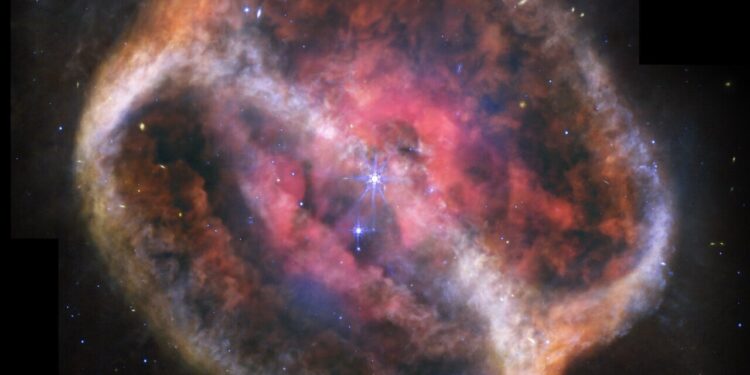What looks like a single large shiny star (but is two) shines with bright purple diffraction tips in the center of a large, diffuse gas and dust cylinder which is on the right. In the center is an emblematic bright pink cloud which occupies about 25% of the view. There are two large rings seen at an angle of about 60 degrees which appear attached at the top left and bottom right. The edges are densest and form shallow V -shaped shapes that go inwards. The rings appear orange at the top left and bottom right, and are blue at the bottom and in the center on the right. There is a diffuse orange material around the body. The black background of space is speckled with tiny stars and galaxies mainly in the Blues and the Yellows. The webb zones have not observed are along the upper edges, a vertical thin near the nebula at the top left, and bottom left and right corners. Credit: NASA, ESA, CSA, STSCI, Michael Sentler (NASA-JPL), Dave Jones (IAC)
The gas and dust ejected by a dying star in the heart of NGC 1514 have become a complete objective thanks to the average infrared data of the James Webb space telescope. Its rings, which are detected only in infrared light, is now similar to fuzzy tufts arranged in tangled patterns, and a network of clearer holes near the central stars shows where a faster material has allowed to pierce.
The rings around NGC 1514 were discovered in 2010, but now webb allows scientists to examine in depth the turbulent nature of this nebula.
This scene has been formed for at least 4,000 years – and will continue to change in many other millennia. In the center are two stars that appear as one in webb observation, and are described with brilliant diffraction tips. The stars follow a tight orbit of nine years elongated and are draped in an arc of dust represented in orange.
One of these stars, which was several times more massive than our sun, played the main role in the production of this scene. Once the external layers of the star have been exhausted, only its hot and compact nucleus has remained. As a white dwarf star, its winds have accelerated and weakened, which could have swept the material in thin shells.
https://www.youtube.com/watch?v=mtfqm7R8QQ0
Its shabby shape
Webb observations show that the nebula is at an angle of 60 degrees, which gives the impression that a box is paid, but it is much more likely that NGC 1514 takes the form of a hourglass with the extinct ends. Look for clues of its pinch size at the top left and bottom right, where the dust is orange and drifts in shallow V shapes. When this star was at its peak of losing equipment, the companion could have approached, causing these unusual forms. Instead of producing a sphere, this interaction could rather have formed rings.
Although the outline of NGC 1514 is most clear, the hourglass also has “sides” which are part of its three -dimensional shape. Look for the dark and semi-transparent orange clouds between its rings which give the nebulous body.
A network of pumped structures
The two rings of the nebula are unevenly illuminated in webb observations, appearing more diffuse at the bottom left and at the top right. They also look vague or textured. Scientists believe that the rings are mainly made up of very small grains of dust which, when affected by the ultraviolet light of the white dwarf star, heat up enough to be detected by webb.
In addition to dust, the telescope also revealed oxygen in its lumpy pink center, especially at the edges of bubbles or holes.
NGC 1514 is also remarkable for what is absent. The carbon and more complex carbon versions of computer science, smoke materials known as polycyclic aromatic hydrocarbons, are common in planetary nebula (shiny gas expansion shells expelled by stars at the end of their lives). None of the two was detected in NGC 1514. More complex molecules may not have had time to form due to the orbit of the two central stars, which mixed the ejected material. A simpler composition also means that the light of the two stars reaches much further, which is why we see the low -shaped light rings.
Planetary nebula NGC 1514 (Wise and Webb images side by side) Credit: NASA, ESA, CSA, STSCI, NASA-JPL, Caltech, UCLA, Michael Sentler (NASA-JPL), Dave Jones (IAC)
What about the bright blue star to the left at the bottom left with diffraction tips slightly smaller than the central stars? This is not part of this scene. In fact, this star is closer to us.
This planetary nebula has been studied by astronomers since the late 1700s. The astronomer William Herschel noted in 1790 that NGC 1514 was the first Sky Deep object to appear truly cloudy – he could not solve what he saw in individual stars in a cluster, like other objects that he has cataloged. With webb, our point of view is considerably clearer.
NGC 1514 is in the constellation of the bull at around 1,500 light years from the earth.
Supplied by the European Space Agency
Quote: WebB brings Dying Star’s energy screen to full concentration (2025, April 15) recovered on April 15, 2025 from
This document is subject to copyright. In addition to any fair program for private or research purposes, no part can be reproduced without written authorization. The content is provided only for information purposes.



